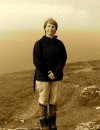
The Sharja Museum of Islamic Art is the eclectic collection of the rule of Sharja, one of the United Emirates. We drove to Sharja from Dubai, which took about an hour. As we drove, it was hard to tell from the sandy sprawl where Dubai ended and Sharja began, but the buildings did start to get smaller. Dubai does tend to tower a bit. Anyway, the ruler of Sharja, his highness the Sheikh Dr. Sultan bin Mohammad al Qassani, is a person who is highly dedicated to art and education. His collection of artifacts is personal and fascinating. In the Freer gallery in DC where they have two galleries of Islamic art, the focus is on the geometric motifs. Here, in gallery 1, we start off with the five pillars of Islam and pictures of the Hajj. Because his highness the Sheikh such an important person, there are several sections of the kiswa in his museum. The kiswa is the gold embroidered skilen covering of the Kaba’a in Mekkah. Here is the piece of the kiswah:
Here is a picture of the Kaba’a. See the gold band around the building? That is where this piece came from. There were lots of pictures of the Mekkah from the early 20th century up to now. It is interesting how Mekkah has changed over the last hundred years. The young lady who was asked to give us our tour was the director of education for the museum. She used to work for a bank, but she said this was more fun. She tried to give us a tour, but just try to give faculty a tour. Jill, the group leader, said that she once heard a tour guide say he preferred pilgrims to teachers because you tell the pilgrims to stay in one place and they will do so, whereas teachers tend to wander off like cats. Oh, but we were a herd of cats. The dear young tour guide did her best to answer questions and guide a bit whenever some one drifted into range, but this group was interested in reading, discussing implications, and debating obscure points. What a great group to hand out with! But I am not sure the tour guide knew what to make of such an incoherent group.
There were some interesting items in the exhibits. There was a whole room dedicated to astrolabes and other astronomical observing instruments. The sign said that the Arab scientists were prompted to develop highly accurate instruments because they had to figure out the lunar calendar, when Ramadan would fall, when the new lunar month would begin, and when the prayer hours would be. Jill Crystal also commented that in the Middle Ages, there was a lot of trade and interaction between Europe and the Middle East. In fact there are Arabic notes taken in the margins of Latin texts, but this close collaboration is practically written out of American and European history books.
In addition to the astrolabes , there was a grenade exhibit:
What did the artist think when he made these nice decoration? Could he have been reflective on the ideas of how ephemeral it is to draw decorations on a land mine? Also, the exhibit said that they had a form of “biological weapons” where they would put a snake or a scorpion into these grenade like mine like things that would cause “devastation to the enemy ranks.” Frankly, I think all you get from putting a poisenous snake into one of the ceramic boxes and launching it at the enemy is a lot of broken pottery and a very disoriented snake.
Another fascinating series of exhibits were the sport-hijab. Here is a tennis hijab.
They also had one for soccer and one for general fitness. The exhibits opined that these sport hijab, called “capsters”, were to allow young women to be “modest yet fashionable:, the implication being that the two could generally be considered mutually exclusive.



1 comment:
How wonderfully odd to hear about grenades that result in a lot of broken pottery with one disoriented snake in the rubble! I really laughed aloud, because my sense of the absurd is so seldom aroused and never so aesthetically or peculiarly. I experienced a most refreshing crosscultural event!
Post a Comment